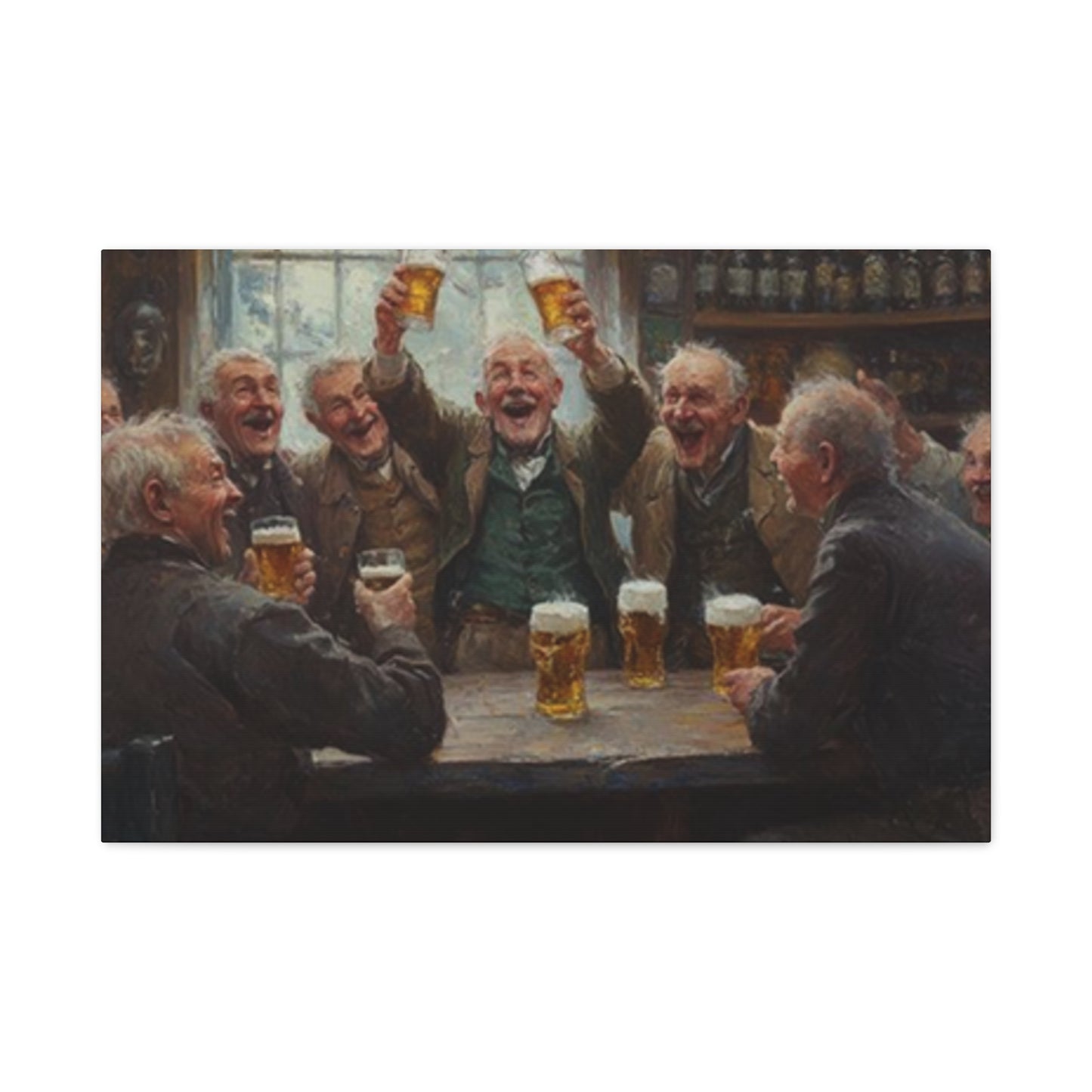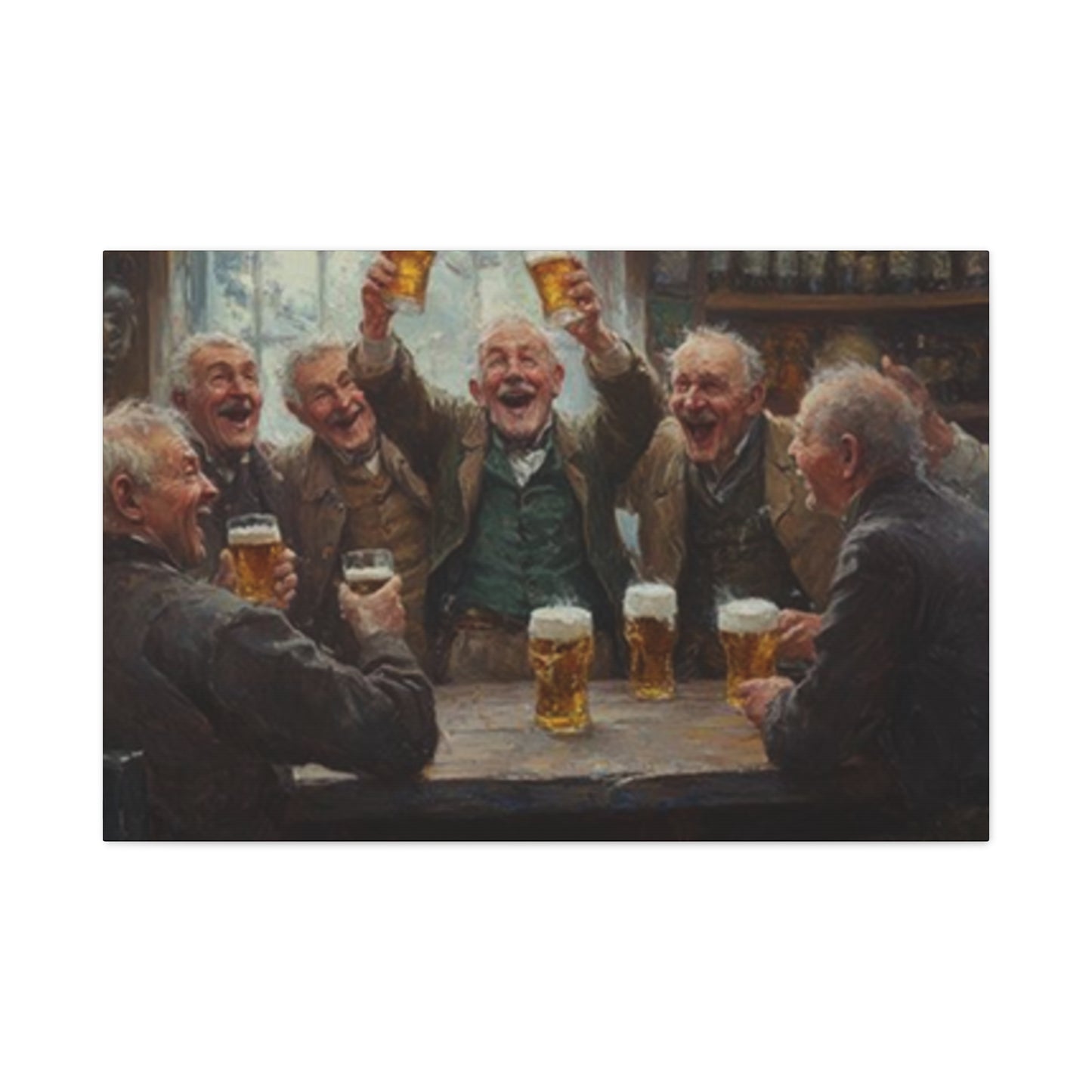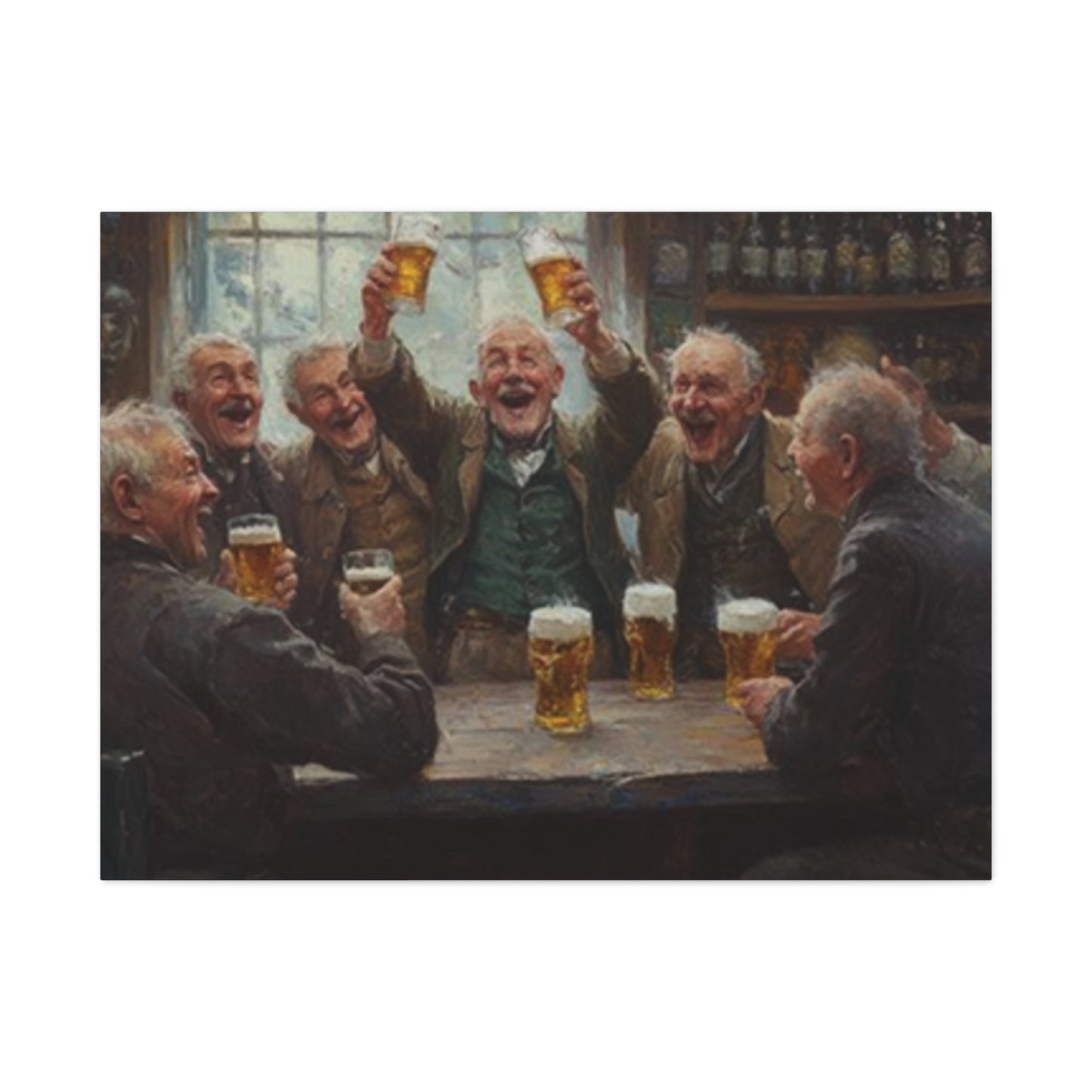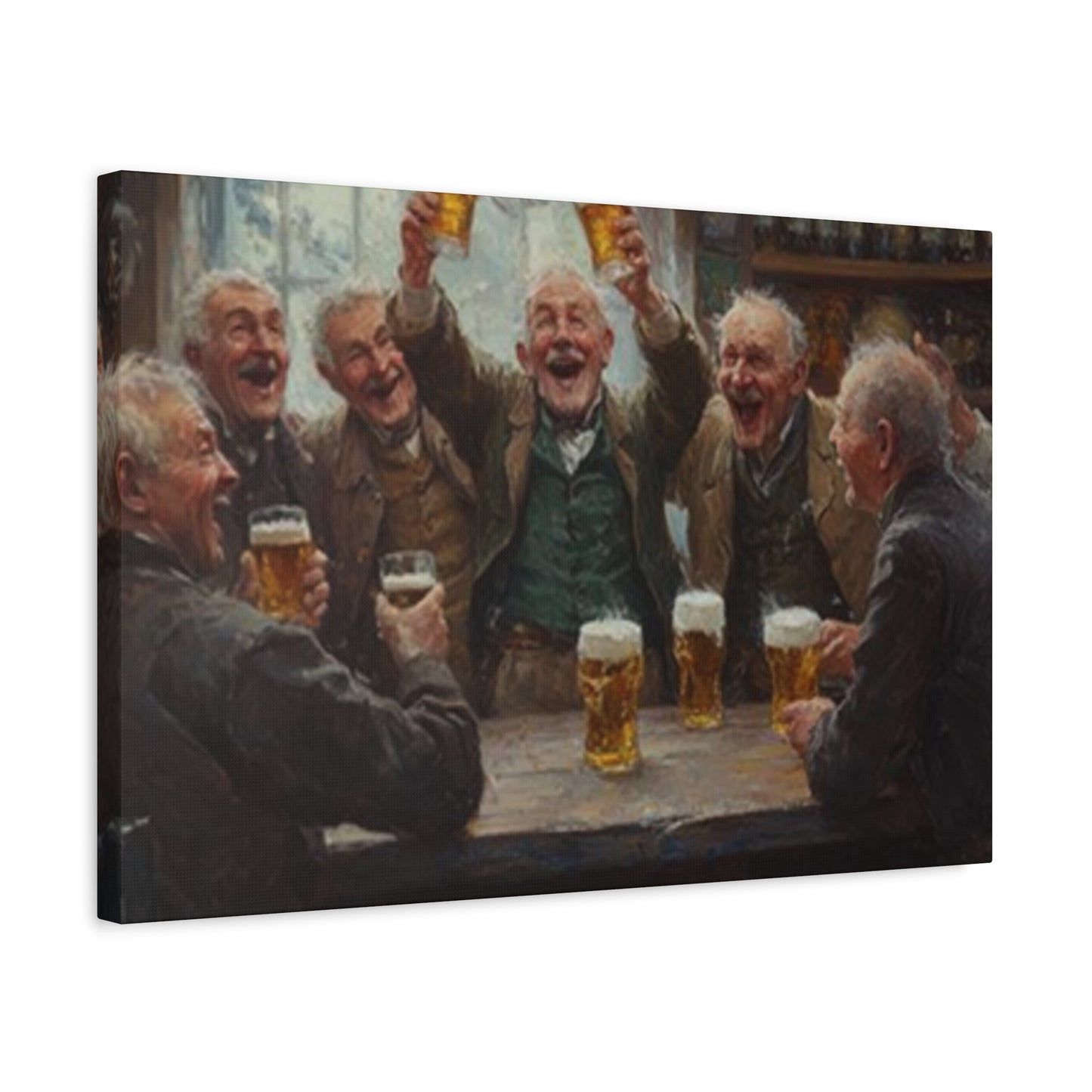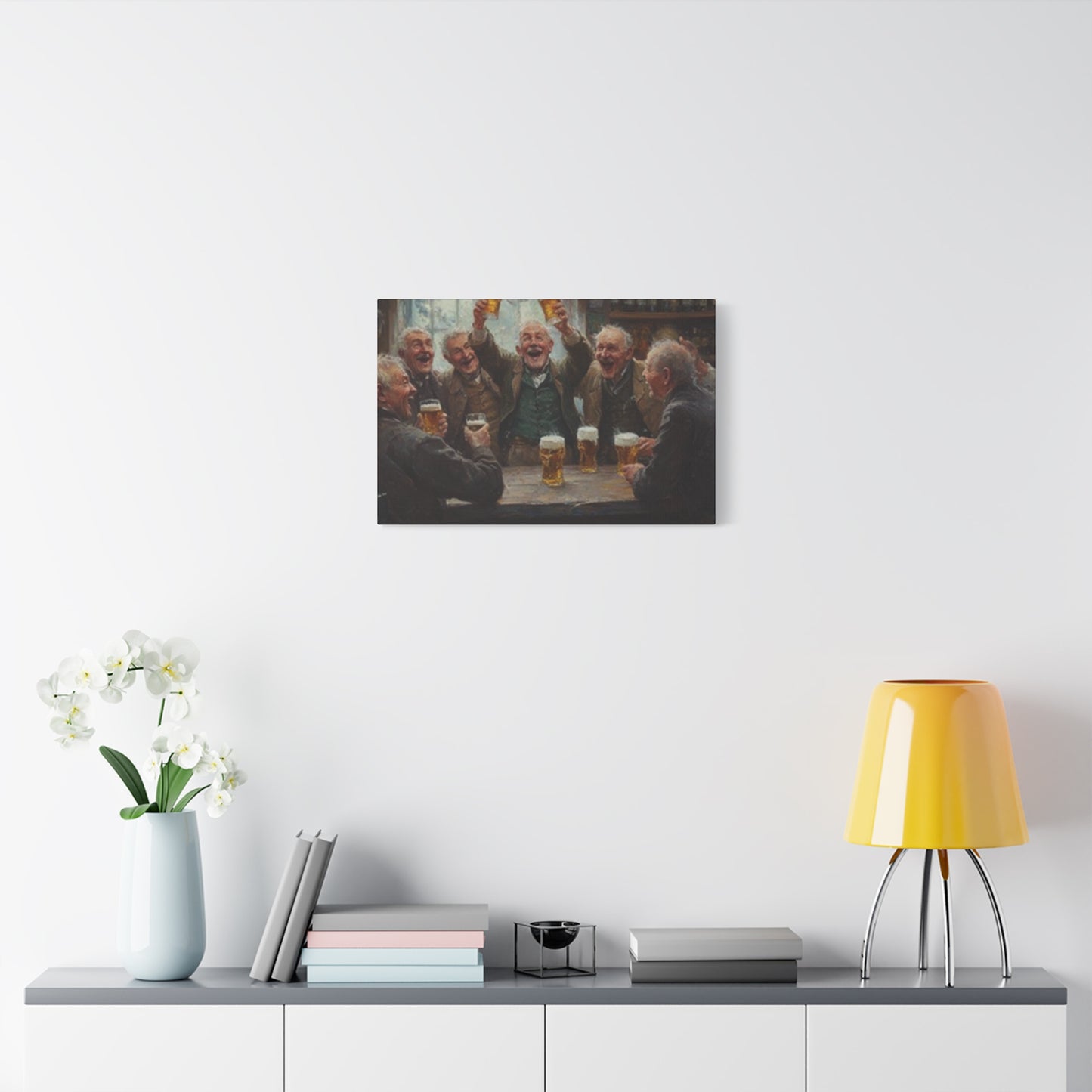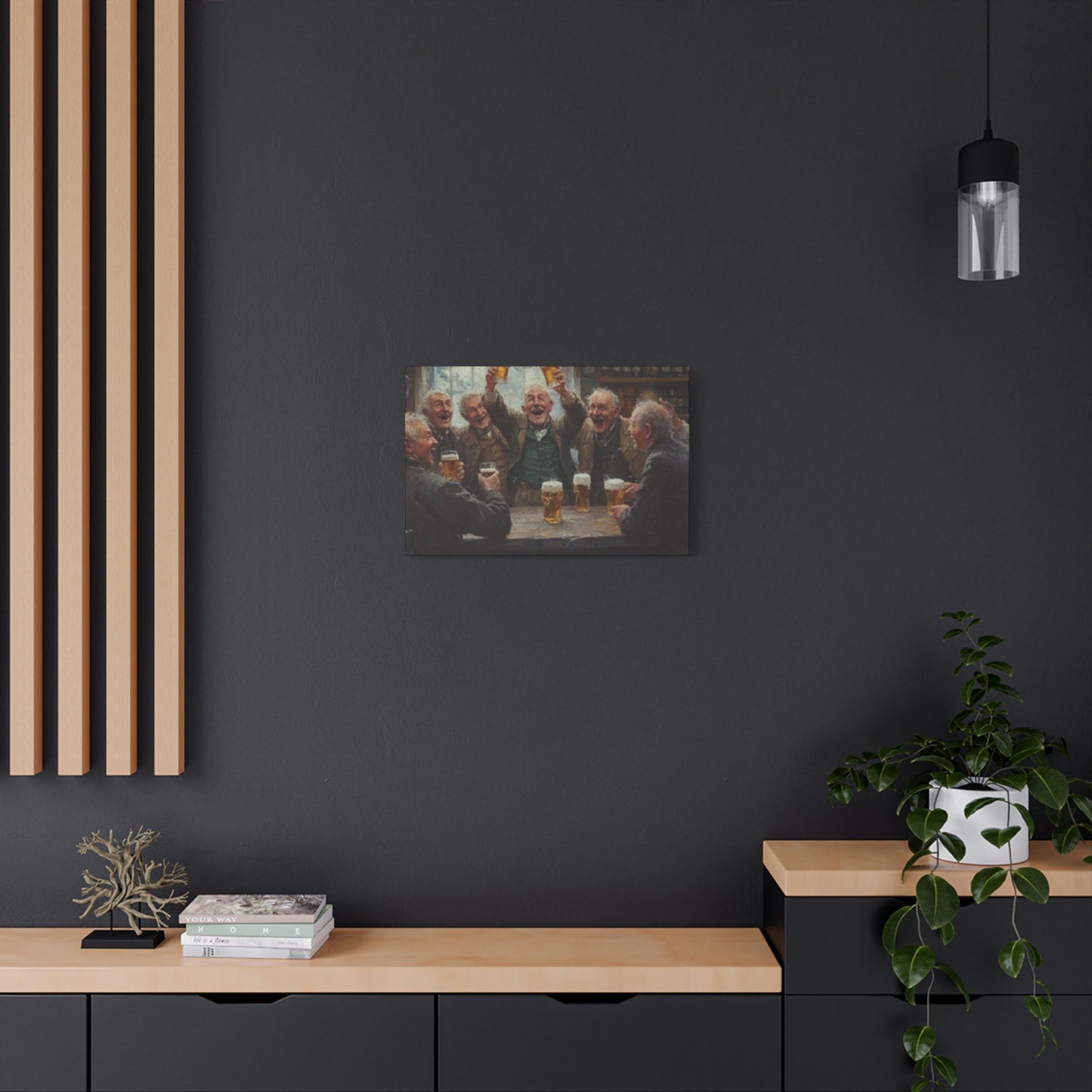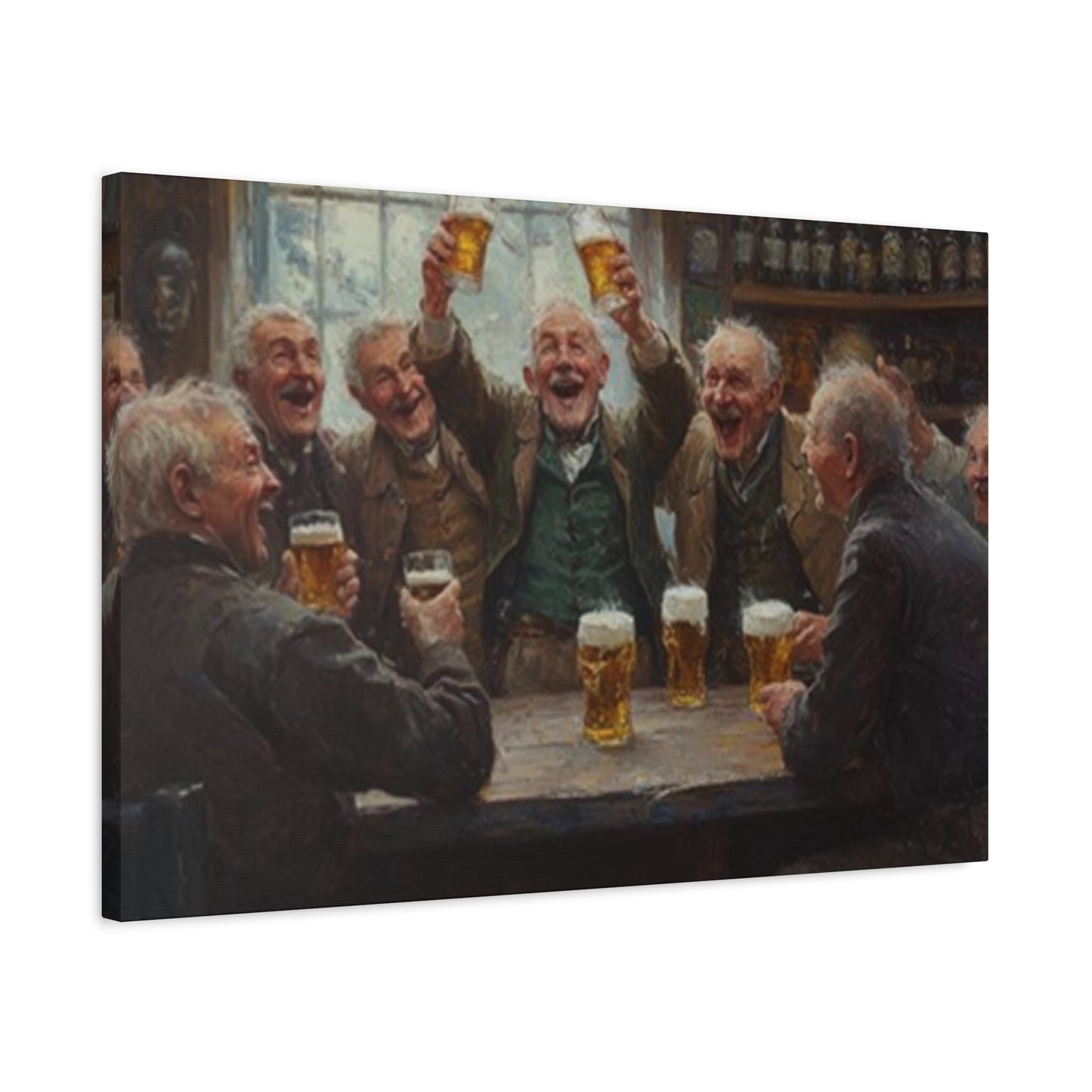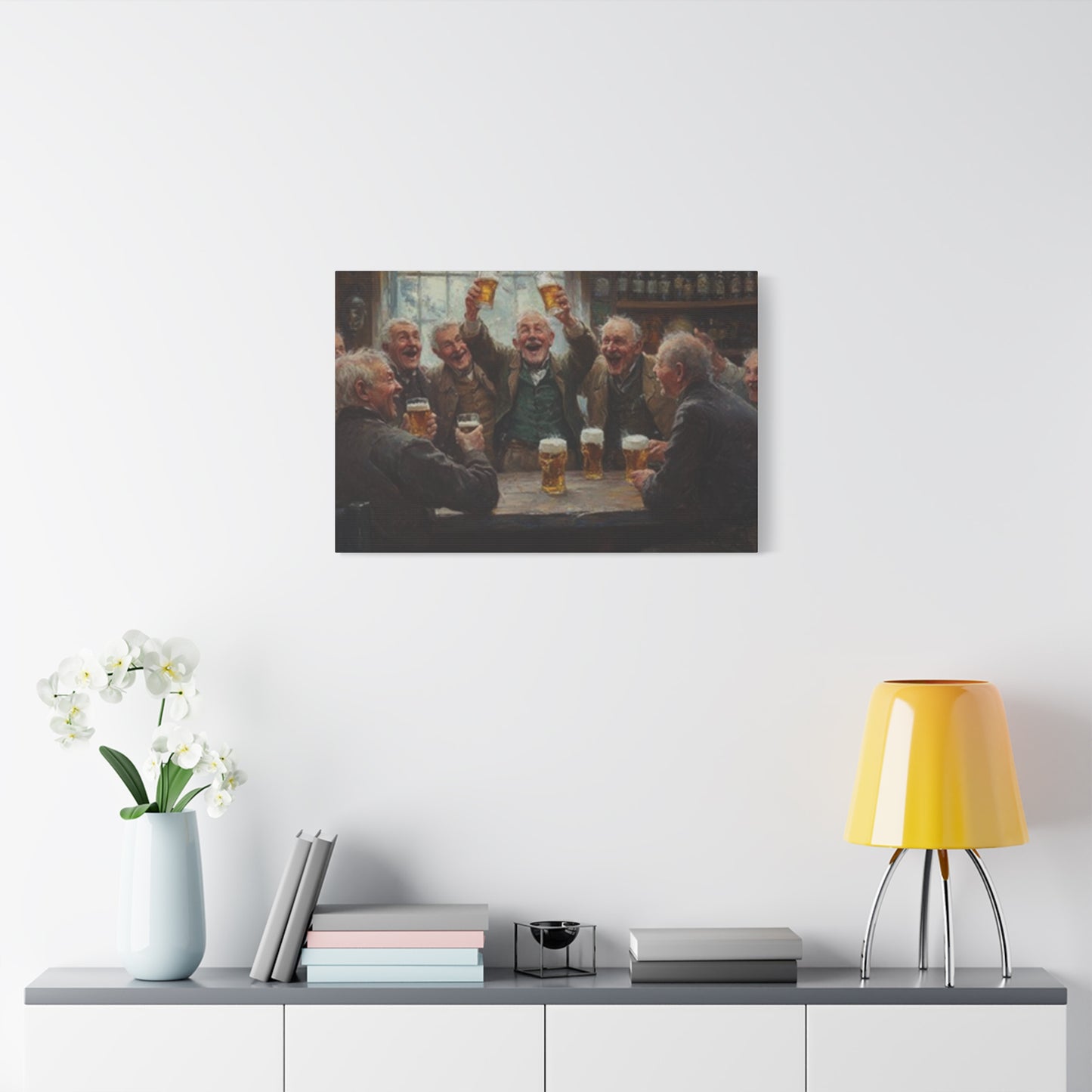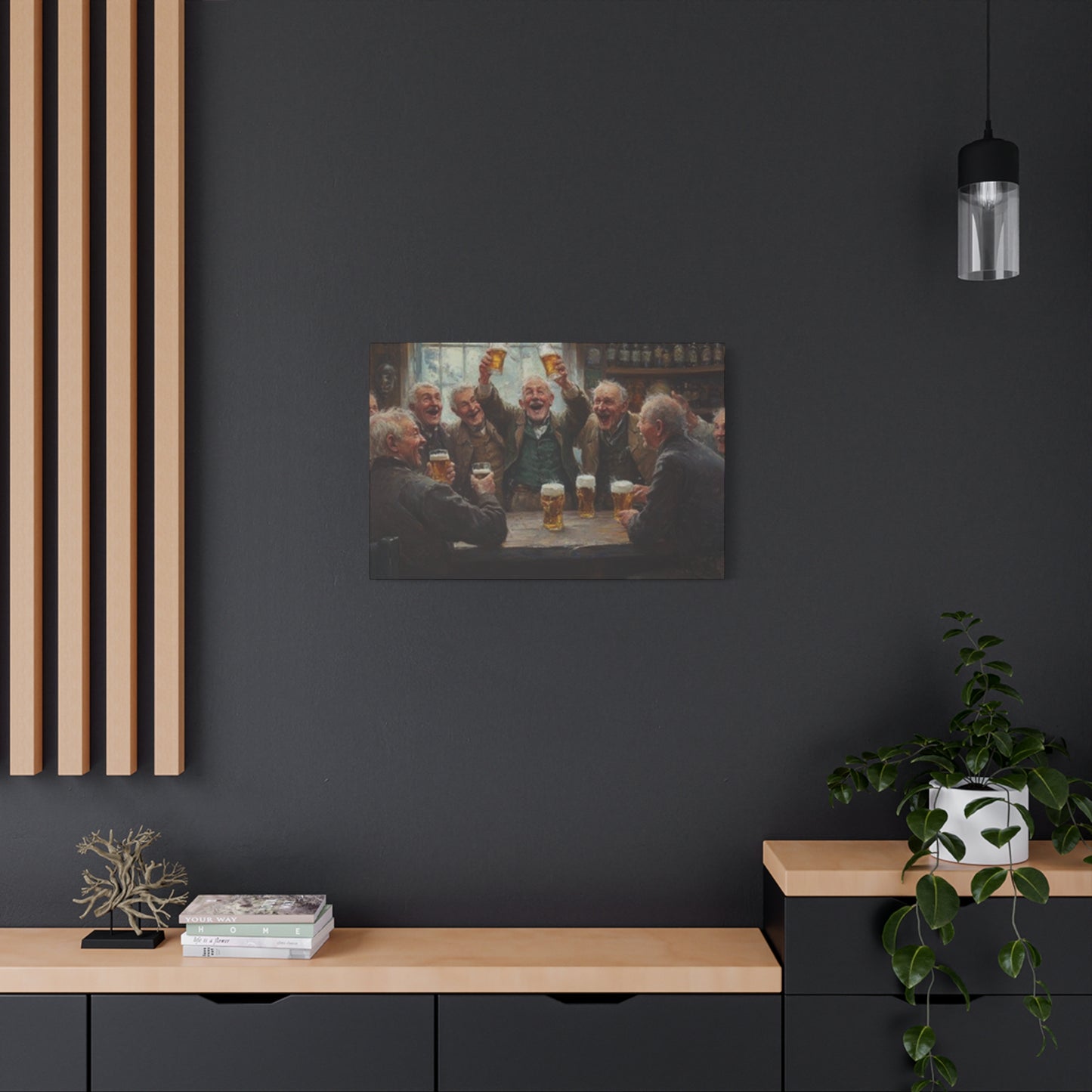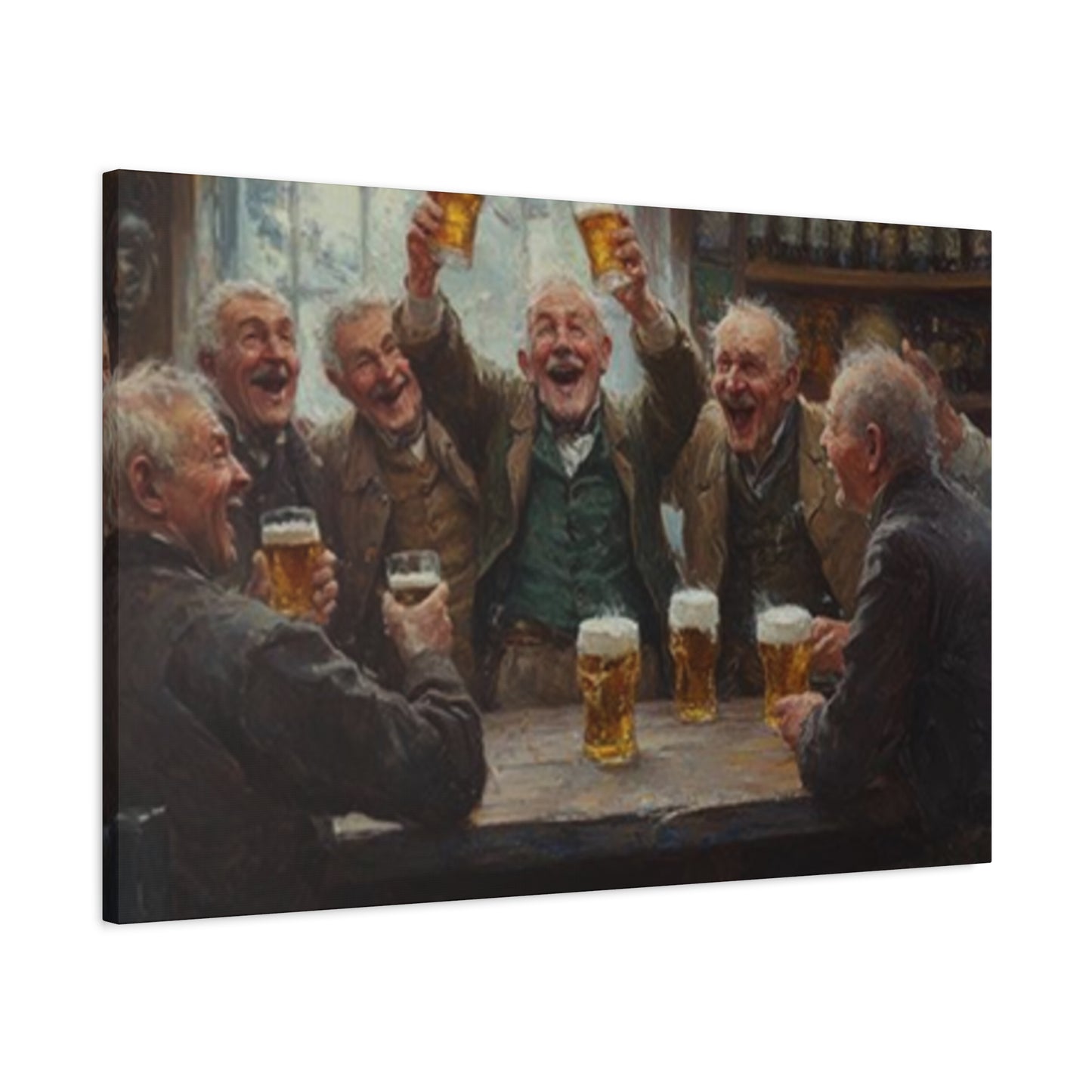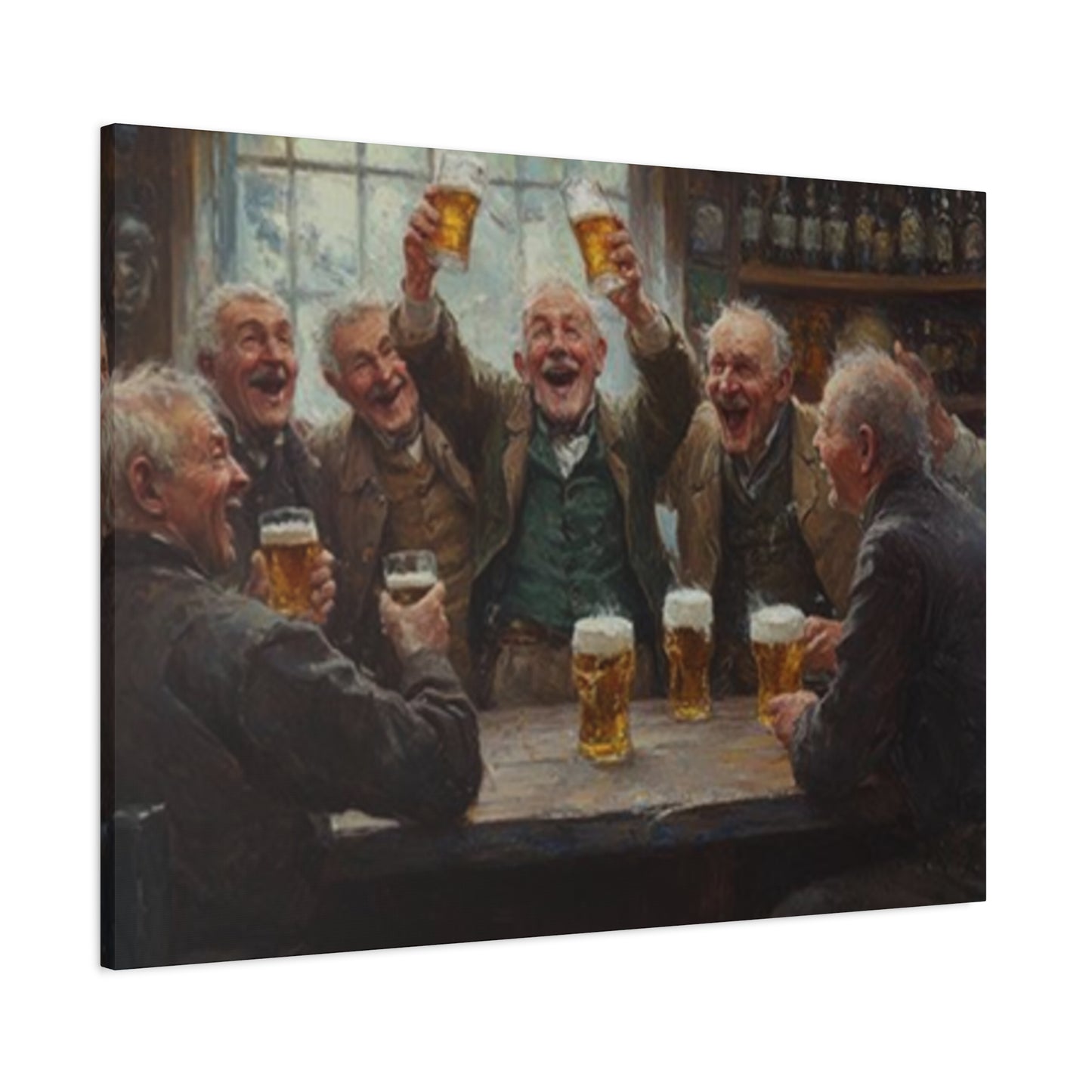Vintage vs. Modern: Exploring Styles in People Enjoying Drinks Wall Art
The beauty of human connection transcends age, and few artistic themes capture this truth more eloquently than visual representations of elderly individuals enjoying beverages together. These artistic pieces serve as powerful reminders of life's enduring joys, the value of companionship, and the richness that comes with years of lived experience. When we observe paintings, prints, or canvases depicting seniors raising glasses in celebration, we witness more than just a social activity; we see the culmination of decades of friendship, the comfort of familiar faces, and the wisdom that comes from understanding what truly matters in life.
Art celebrating elderly people sharing drinks represents a significant cultural statement about how society views aging and social connection. These pieces reject the notion that life's most meaningful moments belong exclusively to youth. Instead, they honor the continued vitality, humor, and zest for life that many seniors maintain throughout their later years. The act of sharing beverages, whether coffee in the morning, tea in the afternoon, or something stronger in the evening, becomes a ritual of connection that deepens with time rather than diminishing.
Capturing Happiness Through Brushstrokes and Colors
Visual representations of seniors enjoying beverages together employ various artistic techniques to convey warmth, nostalgia, and genuine human emotion. Artists who specialize in these themes understand that every wrinkle tells a story, every laugh line represents countless moments of joy, and every shared glance between elderly friends carries the weight of decades of shared experiences. The careful rendering of these details transforms simple scenes into profound statements about the human condition.
When examining artwork featuring elderly companions with their favorite beverages, we notice how artists use color palettes that evoke specific emotional responses. Warm amber tones might suggest the golden glow of sunset years, while rich burgundies and deep browns can evoke the complexity and depth that comes with age. Softer pastels might represent the gentleness and peace that many find in their senior years, while brighter, more vibrant colors can celebrate the continued energy and enthusiasm that refuses to diminish with time.
The composition of these artworks often places subjects in comfortable, familiar settings that enhance the sense of ease and contentment. Whether depicted in cozy living rooms, sun-drenched patios, neighborhood pubs, or garden settings, the environments chosen by artists contribute significantly to the overall narrative. These spaces become characters in their own right, speaking to the importance of having places where we feel safe, welcome, and free to be ourselves.
Lighting plays a crucial role in establishing mood and atmosphere in these artistic pieces. Soft, diffused light might create an intimate, reflective atmosphere, while stronger, more direct lighting can emphasize the joy and energy of the gathering. Many artists employ chiaroscuro techniques, using contrasts between light and shadow to add depth and drama to seemingly simple scenes of people enjoying refreshments together.
Honoring Companionship in Visual Narratives
The relationships depicted in artwork showing elderly individuals sharing beverages often speak to the profound bonds that develop over lifetimes. These are not new acquaintances making small talk; these are people who have weathered storms together, celebrated triumphs, mourned losses, and supported each other through the countless transitions that life brings. The comfort visible in their body language, the knowing glances they exchange, and the natural flow of their interactions all testify to relationships that have been tested and proven over time.
Artists capturing these moments understand the subtle visual cues that distinguish deep friendship from casual acquaintance. The way elderly companions lean toward each other, the relaxed positioning of their bodies, the genuine expressions on their faces—all of these elements combine to create authenticity that viewers can sense intuitively. There is no performance here, no pretense, just the simple pleasure of being in the company of people who understand you completely.
Many of these artistic pieces also celebrate the diversity of senior experiences. Not all elderly people fit into neat stereotypes, and contemporary artists increasingly recognize this reality. Some works depict lively, boisterous gatherings where laughter fills the air and stories fly fast and furious. Others show quieter moments of contemplation, where longtime friends can sit in comfortable silence, their beverages serving as props in a peaceful ritual rather than as the focus of attention.
The beverages themselves often carry symbolic weight in these compositions. A glass of wine might represent sophistication, European traditions, or the simple pleasure of savoring quality over quantity. Beer might evoke working-class solidarity, casual camaraderie, or the reward of a hard life well-lived. Tea or coffee could symbolize daily rituals, the comfort of routine, or the civilized pleasure of unhurried conversation. Whiskey, brandy, or other spirits might suggest celebration, nostalgia, or the complexity that comes from long aging processes—both for the drink and the drinkers.
Visual Storytelling for Living Areas
Selecting artwork for residential spaces involves considering how pieces will interact with the environment and the people who inhabit it. Visual representations of elderly companions enjoying beverages offer unique advantages for home decoration. These works tend to be conversation starters, prompting guests to share their own stories of longtime friendships, memorable gatherings, or beloved elder relatives who enriched their lives.
Living rooms benefit particularly from these types of artistic pieces because they establish a welcoming, sociable atmosphere. When guests enter a space and see artwork celebrating companionship and the simple pleasure of sharing time together, they receive a subtle message about the values the homeowner cherishes. The room becomes implicitly designated as a space for connection, conversation, and the building of memories—exactly what living rooms should be.
Dining areas represent another ideal location for artwork depicting seniors enjoying beverages. These spaces are already dedicated to the social aspects of eating and drinking, making such artwork a natural thematic fit. Placing these pieces in dining rooms reinforces the idea that meals are about more than just nutrition; they are opportunities for bonding, storytelling, and creating the moments that we will look back on fondly in our own later years.
Home bars or entertainment spaces take on additional warmth and character when decorated with visual representations of elderly individuals raising glasses. These artworks serve as reminders that the true purpose of these spaces is not just consumption but connection. They elevate the act of having a drink from mere habit to meaningful ritual, encouraging homeowners and their guests to be more present and appreciative during their time together.
Even bedrooms can benefit from carefully chosen pieces depicting senior companionship. While not the most obvious location for such artwork, a well-selected piece in a master bedroom can serve as a daily reminder of relationship goals—of the kind of partnership that endures, deepens, and brings joy even in advanced years. For couples, these images can represent aspirations for their own future together.
Hallways and entryways, often overlooked in decorating plans, become more interesting and inviting when adorned with artwork showing elderly friends enjoying beverages. These transitional spaces gain personality and purpose, transforming from mere passageways into gallery-like areas that reward attention. Visitors moving through these spaces receive multiple impressions of a home that values relationships, history, and the celebration of life's simple pleasures.
Business Establishment Applications
Commercial venues benefit significantly from carefully curated visual representations of seniors enjoying social drinking. Establishments that serve beverages—whether coffee shops, wine bars, pubs, breweries, or cocktail lounges—can enhance their atmosphere and brand identity through strategic artwork selection.
Traditional pubs and taverns particularly suit artwork depicting elderly patrons enjoying their beverages. These pieces speak to the establishment's role as a community gathering place, a third space between home and work where people come not just to drink but to connect. Artwork showing older regulars laughing together suggests that this is a place where customers become family, where you can be yourself, and where your loyalty will be rewarded with genuine relationship rather than mere transactional service.
Wine bars and tasting rooms can benefit from more refined representations of seniors savoring their drinks. These pieces should emphasize appreciation, sophistication, and the pleasure that comes from taking time to truly experience what you are consuming. Artwork depicting elderly wine enthusiasts engaged in animated discussion about their glasses suggests that the establishment caters to connoisseurs, to people who understand that great wine is meant to be shared and discussed, not just consumed.
Coffee houses and cafes find particular resonance in artwork showing seniors enjoying their favorite beverages in relaxed settings. These pieces can emphasize the role of coffee shops as community hubs, places where people of all ages come to read, think, converse, and simply be. Depicting elderly patrons in such artwork sends a message of inclusivity, suggesting that everyone is welcome regardless of age, and that the establishment values all of its customers equally.
Retirement communities and senior living facilities represent perhaps the most natural application for artwork celebrating elderly individuals enjoying beverages together. Common areas, dining halls, and social spaces become warmer and more inviting when decorated with images that honor the residents' stage of life rather than ignoring it. These pieces validate the social lives and relationships of seniors, acknowledging that their friendships and social rituals are just as valuable as those of younger people.
Healthcare facilities serving elderly populations can also benefit from these artistic choices. Waiting rooms, consultation areas, and hallways in medical offices, hospitals, and clinics become less institutional and more humane when adorned with positive representations of senior life. These images can reduce anxiety, create a more positive atmosphere, and remind both staff and patients that the elderly are whole people with rich social lives, not just collections of medical conditions.
Restaurant spaces gain character and warmth from artwork depicting seniors enjoying meals and beverages together. These pieces reinforce the idea that dining out is about experience and connection, not just food consumption. They can make elderly diners feel more welcome and valued while simultaneously reminding younger patrons to appreciate the present moment and the people they are sharing it with.
Historical Context in Senior Social Art
Artistic representations of elderly individuals enjoying beverages together did not emerge in a vacuum. They draw from rich traditions in art history while also responding to contemporary cultural conversations about aging, community, and the good life. Understanding this context deepens our appreciation of these works and helps us recognize why they resonate so strongly with contemporary audiences.
Dutch Golden Age painting established many conventions still used today in depicting social drinking. Artists like Jan Steen, Frans Hals, and Adriaen Brouwer created lively tavern scenes that celebrated the social aspects of drinking while also sometimes offering moral commentary. While these historical works often featured younger subjects, they established artistic traditions for capturing the warmth, energy, and human connection that occurs when people gather over beverages.
Impressionist and Post-Impressionist artists brought new approaches to depicting social scenes in cafes and restaurants. Pierre-Auguste Renoir's paintings of Parisian cafe life, Edgar Degas's studies of people in bars and restaurants, and Henri de Toulouse-Lautrec's cabaret scenes all demonstrated how artists could capture the atmosphere and human dynamics of social drinking spaces. While not specifically focused on elderly subjects, these works influenced how later artists would approach similar themes.
The social realist movements of the early twentieth century often depicted working-class and elderly subjects with dignity and respect, moving away from caricature or condescension. Artists associated with these movements understood that the lives of ordinary people, including older people, deserved serious artistic attention. Their work helped establish that paintings of seniors in everyday activities were legitimate subjects for serious art rather than just genre scenes or curiosities.
Contemporary artists working in this tradition bring fresh perspectives informed by current conversations about aging, ageism, and the value of elder wisdom. As societies worldwide grapple with demographic aging and question youth-centric cultural values, artwork that celebrates elderly people living full, social lives takes on new significance. These pieces become subtle forms of activism, challenging stereotypes and asserting that older people remain vital members of communities.
Connections in Visual Representations
The emotional impact of artwork depicting seniors sharing beverages stems from multiple sources. These pieces activate memories, trigger associations, and connect with deep-seated values about relationships, aging, and the meaning of a life well-lived. Understanding these emotional dimensions helps explain why such artwork resonates so powerfully with viewers across generations.
For younger viewers, these artistic representations often evoke specific memories of beloved grandparents, elder relatives, or family friends. The warmth visible in depictions of elderly companions enjoying time together recalls feelings of safety, love, and acceptance that many people associate with their relationships with older family members. A painting of seniors laughing over drinks might remind someone of summers spent at a grandparent's house, of the sound of their grandmother's laugh, or of the feeling of being included in adult conversations for the first time.
Middle-aged viewers often see in these images their own futures and the futures they hope for their aging parents. Artwork showing vibrant, socially engaged seniors provides reassurance that aging does not mean isolation or irrelevance. These pieces can reduce anxiety about getting older by presenting attractive visions of what life in later years can look like—full of friendship, laughter, and continued pleasure in life's simple joys.
Elderly viewers themselves often respond to these artworks with recognition and validation. Seeing positive, non-stereotypical representations of people their own age engaged in activities they enjoy confirms that their experiences matter and deserve artistic attention. These pieces push back against cultural tendencies to render older people invisible or to depict them only in limited, often negative contexts.
The universality of shared beverages as a social ritual adds to the emotional accessibility of these artworks. Across cultures and throughout history, humans have gathered to share drinks as a way of marking occasions, strengthening bonds, and creating community. Artwork depicting this activity taps into very deep human patterns, making these pieces feel familiar and meaningful even to viewers who come from very different backgrounds than the subjects portrayed.
Artists working in this genre often capture subtle emotional moments that resonate because of their authenticity. A hand reaching out to refill a friend's glass, eyes crinkling with genuine laughter, the slight lean forward that indicates deep engagement in conversation—these small details carry enormous emotional weight. They distinguish artwork that truly understands its subject matter from pieces that merely depict it superficially.
Approaches in Creating Senior Social Art
Creating compelling visual representations of elderly individuals enjoying beverages requires technical skill across multiple dimensions. Artists must master not just basic drawing and painting techniques but also the specific challenges involved in rendering aged faces, capturing group dynamics, and creating atmospheres that feel authentic rather than staged.
Portraying elderly faces accurately requires understanding how aging affects facial structure, skin texture, and expressive features. Skilled artists render wrinkles not as mere lines but as complex topographical features with their own highlights, shadows, and depths. They understand how skin drapes differently over aging bone structure, how light interacts with various skin textures, and how to depict these elements while maintaining dignity and avoiding caricature.
Capturing authentic expressions and emotions presents particular challenges in depicting elderly subjects. Genuine smiles engage different facial muscles than forced or posed expressions, creating subtle differences that viewers sense instinctively. Artists must train their eyes to recognize and reproduce these authentic moments, often working from photographs of real interactions or sketching live subjects in natural social settings.
Group composition in scenes of multiple elderly individuals sharing drinks requires careful attention to spatial relationships, sight lines, and interactive dynamics. The artist must create a sense that these people are truly engaged with each other rather than simply positioned in the same frame. This involves understanding how people naturally arrange themselves in social situations, how body language communicates relationship quality, and how to guide the viewer's eye through a complex multi-figure composition.
Color choices affect mood dramatically in these works. Warm color palettes tend to create feelings of comfort, nostalgia, and contentment—generally appropriate for celebrations of senior friendship. However, artists must avoid descending into excessive sentimentality or making works feel dated. Balancing warmth with sophistication, nostalgia with contemporaneity, requires refined color sensibility and often extensive experimentation.
Lighting decisions separate adequate artwork from exceptional pieces. Dramatic lighting can add visual interest and emotional depth, but must feel motivated and natural rather than arbitrary. Soft, diffused light might better serve intimate conversations, while brighter light suits more energetic gatherings. Artists must decide not just where light comes from but what quality it has—the warm glow of lamplight creates very different atmospheres than cooler daylight or the particular ambiance of candlelight.
Background elements and settings require as much attention as foreground subjects. A poorly rendered or generic background undermines even excellent figure work. Skilled artists create environments that feel specific and lived-in, with telling details that add narrative depth without distracting from main subjects. Books on shelves, photographs on walls, worn furniture, favorite glassware—these elements contribute to authenticity and provide visual richness.
Cultural Perspectives on Elder Social Life
Artistic representations of seniors enjoying beverages together reflect and influence cultural attitudes toward aging, socializing, and the role of elderly people in communities. Different cultural traditions bring varying perspectives to these themes, and artists working in this area often navigate multiple cultural references and expectations.
Mediterranean cultures have long celebrated multigenerational socializing, often centered around meals and beverages. In these traditions, elderly family members remain fully integrated into social life, and their presence at gatherings is expected and valued. Artwork reflecting these cultural values shows seniors not as exceptions or novelties but as natural participants in community life, often depicted in outdoor settings that emphasize the public and communal nature of these gatherings.
Asian artistic traditions often emphasize respect for elders and the wisdom that comes with age. Visual representations influenced by these traditions might show elderly individuals in positions of honor at gatherings, with other participants showing deference through body language and positioning. The beverages shared might be tea or sake, and the rituals surrounding their consumption might receive as much artistic attention as the social interactions themselves.
Northern European traditions often associate certain beverages, particularly beer and spirits, with working-class solidarity and democratic social structures. Artwork influenced by these traditions might depict elderly workers or retired laborers enjoying well-earned leisure time in unpretentious settings. These pieces often emphasize equality and camaraderie, showing people who have maintained friendships across decades of shared labor and life experience.
American approaches to depicting elderly social life reflect the country's complex relationship with aging. At their best, these works celebrate individualism, continued vitality, and the idea that later life can be as rich and enjoyable as any other period. At their worst, they can reflect cultural anxieties about aging, attempts to deny or minimize the realities of growing older, or tendencies to segregate elderly people into separate social spheres.
Contemporary global culture increasingly challenges rigid cultural stereotypes about aging while also drawing from diverse traditions to create richer, more nuanced representations. Artists today can access visual references and cultural influences from around the world, leading to works that blend perspectives and create new approaches to celebrating elderly social life.
Symbolism in Senior Beverage Art
Visual representations of elderly people enjoying beverages often operate on multiple symbolic levels. Surface meanings—people having drinks together—give way to deeper themes about time, mortality, celebration, and the human need for connection. Understanding these symbolic dimensions enriches our engagement with these artworks.
The act of raising a glass functions as a universal gesture of celebration, acknowledgment, and connection. When elderly individuals perform this gesture in artwork, it carries additional weight—these are people who have lived long enough to understand what truly deserves celebration and what represents mere distraction. Their toasts feel more meaningful, their celebrations more hard-won and therefore more precious.
Beverages themselves carry rich symbolic associations. Wine, with its aging process that can span decades, parallels human aging. A fine wine requires time to develop its character, just as humans often become more interesting, complex, and valuable with age. This parallel makes wine particularly apt in artwork celebrating elderly life, suggesting that time is not just something to be endured but can be transformative in positive ways.
Beer, often associated with working-class culture and everyday pleasure, symbolizes democratic values and the dignity of ordinary life. In artwork depicting elderly individuals enjoying beer, we see an assertion that working-class lives and experiences deserve artistic attention and celebration. These pieces honor lifetimes of labor, loyalty, and finding joy in simple pleasures rather than chasing status or luxury.
Coffee and tea, as daily ritual beverages, represent continuity, routine, and the comfort of familiar patterns. Elderly people depicted enjoying these drinks embody the value of having established rhythms and rituals in life. These pieces suggest that there is deep satisfaction in having favorite cups, preferred preparation methods, and habitual times for these beverages—that creating and maintaining these small traditions contributes to a well-lived life.
Stronger spirits—whiskey, brandy, cognac—carry associations with contemplation, sophistication, and the kind of appreciation that requires experience. An elderly person savoring a quality spirit in artwork suggests someone who has developed refined taste, who understands the value of quality over quantity, and who has earned the right to enjoy life's finer things without apology or pretense.
Social Drinking Depicted in Art
Artwork showing elderly individuals enjoying beverages together engages with psychological realities about human social needs, the importance of ritual, and the role of shared activities in maintaining relationships. These pieces reflect and reinforce important truths about human psychology and wellbeing.
Social isolation represents a significant health risk for elderly people, with research consistently showing that maintaining strong social connections contributes to longer, healthier, happier lives. Artwork depicting vibrant social engagement among seniors serves as a subtle reminder of these psychological realities. These pieces normalize continued socializing in later life and can even inspire viewers to prioritize maintaining their own social connections as they age.
The ritual aspects of sharing beverages play important psychological roles. Rituals provide structure, create predictability, and mark transitions in our days and lives. Elderly people who maintain social rituals—whether daily coffee with friends or weekly get-togethers—benefit from the psychological stability and sense of continuity these practices provide. Artwork capturing these rituals validates their importance and beauty.
Shared activities facilitate connection by providing natural conversation topics and creating parallel focus that can reduce social anxiety. People gathered around beverages have a built-in reason to be together that does not require constant conversation or entertainment. This creates space for comfortable silences, natural conversation flow, and the kind of relaxed togetherness that characterizes the best friendships.
Laughter and joy, frequently depicted in these artworks, trigger the release of endorphins and other beneficial neurochemicals. Representations of elderly people laughing together remind us that humor and joy remain important throughout life, that the ability to find things funny or delightful does not diminish with age. These pieces challenge stereotypes about elderly people being uniformly serious, sad, or focused only on decline and loss.
The presence of familiar faces and trusted friends provides psychological safety that allows people to be authentically themselves. Artwork capturing the comfort visible in elderly friends sharing drinks illustrates this psychological dynamic. These are people who can be vulnerable, silly, serious, or quiet without fear of judgment—a form of acceptance that becomes increasingly precious with age.
Material Considerations for Artwork Display
Selecting appropriate materials and display methods for artwork depicting seniors enjoying beverages affects both the longevity of the piece and how effectively it communicates with viewers. Different materials and presentation approaches create different effects and suit different environments.
Canvas prints offer several advantages for this type of artwork. The texture of canvas adds depth and visual interest, making pieces feel more substantial and gallery-worthy. Canvas naturally suits artwork with a painterly quality, and its durability makes it appropriate for high-traffic areas or commercial spaces where artwork might face more challenging conditions than in carefully maintained residential settings.
Paper prints, particularly those using high-quality archival papers and inks, can capture fine details with remarkable clarity. For artwork emphasizing facial expressions, small gestures, or subtle emotional moments, paper prints might better serve the artist's intentions than other media. However, paper prints typically require more careful display considerations, including proper framing and protection from direct sunlight, to ensure longevity.
Metal prints create modern, striking presentations that can give traditional subject matter contemporary appeal. The luminosity and depth possible with metal printing can make colors particularly vivid and create interesting visual effects. However, the sleek, modern quality of metal prints might not suit all artistic visions, particularly those emphasizing warmth, nostalgia, or traditional values.
Wood panel prints offer unique textural qualities and can create rustic or organic presentations. For artwork depicting elderly individuals in natural settings or emphasizing connection to tradition and heritage, wood panels provide appropriate material choices. The grain of the wood can add visual interest and reinforce thematic elements about natural aging processes and organic beauty.
Framing decisions significantly impact how artwork communicates. Simple, understated frames typically serve narrative artwork best, keeping viewer focus on the image rather than the presentation. However, more elaborate framing might suit certain artistic approaches, particularly those referencing art historical traditions or creating deliberately formal presentations. Frame color, material, and style should harmonize with both the artwork and the intended display environment.
Size considerations affect impact and appropriate placement. Large-scale pieces create commanding focal points and suit spacious areas where they can be viewed from appropriate distances. Smaller works invite closer inspection and work well in intimate spaces or as parts of gallery wall arrangements. Series of related images in consistent sizes can create narrative progressions or thematic variations.
Marketing Perspectives for Beverage Social Art
From commercial perspectives, artwork depicting elderly individuals enjoying beverages serves multiple marketing functions for various businesses and organizations. Understanding these applications helps both artists and business owners recognize opportunities for mutually beneficial collaborations.
Beverage industry companies, including wineries, breweries, distilleries, and coffee roasters, can benefit from artwork that shows their products being enjoyed in positive social contexts. Elderly consumers represent significant market segments for many premium beverages, and artwork depicting age-appropriate consumption reinforces brand values around quality, tradition, and sophisticated appreciation rather than excessive or immature drinking behaviors.
Hospitality businesses, including hotels, resorts, and cruise lines, increasingly recognize that elderly travelers represent valuable customer segments. Artwork in these establishments that shows positive, engaging depictions of senior social life sends welcoming messages to older guests while also shaping younger guests' expectations about their own aging process. These pieces contribute to creating age-friendly environments.
Furniture and home decor retailers can use such artwork in showrooms and marketing materials to help customers visualize how their products might be used to create warm, social living environments. A comfortable seating arrangement looks even more appealing when shown with artwork depicting the kinds of pleasant social gatherings customers hope to host in their own homes.
Senior living communities and retirement developments face marketing challenges around changing perceptions of aging. Artwork in their facilities and marketing materials that shows vibrant, socially engaged elderly people contradicts negative stereotypes and helps potential residents envision positive futures for themselves in these communities.
Art galleries and publishers specializing in representational or narrative artwork can market these pieces to multiple demographic segments. Younger buyers purchasing gifts for elderly relatives, middle-aged buyers planning for their own futures, and elderly buyers seeking artwork that reflects their experiences all represent potential markets for well-executed pieces in this genre.
Social Senior Art
Artwork depicting elderly individuals enjoying beverages together offers valuable educational applications across multiple contexts, from formal educational settings to corporate training environments and community education programs.
Medical and nursing education programs can use such artwork to encourage more holistic views of elderly patients. Healthcare students often receive extensive training in pathology and treatment but less exposure to positive visions of elder life. Artwork showing vibrant social engagement reminds future healthcare providers that their elderly patients are whole people with rich social lives, not just collections of symptoms requiring treatment.
Psychology and gerontology courses can analyze these artworks as cultural texts revealing attitudes toward aging. Students can examine how different artistic approaches either reinforce or challenge stereotypes about elderly people, exploring questions about representation, dignity, and the visual communication of values about aging and quality of life.
Corporate training programs addressing age diversity and multigenerational workplace dynamics can use artwork depicting positive intergenerational social interactions. While many pieces in this genre focus primarily on elderly subjects, some include younger participants as well, modeling the kind of cross-generational connection that benefits contemporary workplaces.
Community education programs for seniors can use artwork depicting their peers in positive social contexts as discussion starters for conversations about maintaining social connections, creating rituals, and building community. Seeing others their age portrayed positively in art can encourage participants to invest in their own social lives and relationships.
Art education programs can study these works as examples of narrative art, portraiture, group composition, and the artistic challenges involved in depicting authentic human emotion and interaction. Technical analysis of successful examples helps developing artists understand what makes certain works compelling while others fail to engage viewers.
Museum education programs can position artwork showing elderly social life within broader contexts of social history, cultural studies, and the history of aging. Exhibition materials and gallery talks can explore how attitudes toward elderly people have changed over time and how art reflects and influences these evolving perspectives.
Therapeutic Applications in Elder Care
Visual representations of seniors enjoying beverages together can serve therapeutic purposes in various elder care contexts, from memory care facilities to rehabilitation centers and mental health settings serving elderly populations.
Memory care facilities use familiar imagery to help residents connect with preserved memories and maintain sense of self despite cognitive decline. Artwork depicting social scenes similar to those residents might have experienced throughout their lives can spark conversations, trigger positive memories, and create opportunities for social engagement even when other forms of communication have become challenging.
Occupational therapy programs can use such artwork as prompts for activities and exercises. Discussions about the scenes depicted, the relationships shown, and personal memories they evoke serve therapeutic purposes while feeling natural and enjoyable rather than overtly clinical. These conversations can assess cognitive function, encourage reminiscence, and facilitate social interaction among residents.
Art therapy approaches with elderly clients can incorporate both viewing and creating artwork on these themes. Discussing professional artwork can lead into activities where participants create their own images of favorite social memories, important relationships, or hopes for current and future social connections. The creative process offers multiple therapeutic benefits while the specific theme provides accessible subject matter.
Facilities addressing depression and isolation in elderly populations can strategically place artwork showing positive social engagement in common areas, therapy spaces, and even individual rooms. Environmental psychology research demonstrates that the visual environment affects mood and behavior. Surrounding isolated or depressed individuals with positive images of social connection can contribute to treatment approaches addressing these issues.
Reality orientation programs in facilities serving residents with dementia use environmental cues to help residents maintain connection with present time and place. Artwork depicting contemporary or historically recent social scenes provides more appropriate and useful environmental information than generic or abstract art might offer.
Palliative and hospice care environments can benefit from artwork that celebrates life and relationships rather than focusing on decline or loss. Images of elderly people enjoying companionship and life's pleasures affirm that patients' lives have been full and meaningful, supporting both patients and families during difficult transitions.
Contemporary Trends in Depicting Senior Social Life
Current artistic approaches to representing elderly individuals enjoying beverages reflect broader trends in contemporary art while also responding to specific cultural conversations about aging in modern societies.
Increased diversity in representation marks a significant contemporary trend. Earlier artwork in this genre often depicted elderly people as uniformly white, middle-class, and conventionally partnered. Contemporary artists increasingly recognize that elderly populations include people of all races, ethnicities, gender identities, sexual orientations, and socioeconomic backgrounds. More inclusive representation both reflects demographic realities and challenges narrow conceptions of who elderly people are.
Movement away from excessive sentimentality characterizes much contemporary work in this area. While emotional warmth remains central to these pieces, contemporary artists often avoid the heavy-handed nostalgia or condescension that sometimes marked earlier approaches. Current works tend to depict elderly subjects with more agency, dignity, and complexity, recognizing them as fully realized individuals rather than symbols or types.
Integration of contemporary settings and references helps artwork feel current rather than dated. While some pieces intentionally evoke historical periods or traditional approaches, many contemporary artists depict elderly people in clearly modern environments, wearing current fashions, and engaging with contemporary culture. This approach challenges assumptions that elderly people exist outside contemporary life or remain frozen in the past.
Exploration of previously marginalized narratives represents another significant trend. Artists are creating works that depict elderly LGBTQ individuals, elderly people from various ethnic and cultural communities, elderly people with disabilities, and other groups whose experiences have been underrepresented in art depicting senior life. These works both serve these communities and broaden all viewers' understanding of the diversity of aging experiences.
Technical experimentation with style, medium, and approach continues to evolve. While representational artwork remains popular in this genre, some contemporary artists bring abstract elements, experimental techniques, or mixed media approaches to depicting senior social life. These innovations keep the genre fresh and can attract audiences who might not typically engage with traditional representational work.
Ethical Considerations in Representing Elderly Subjects
Creating and displaying artwork depicting elderly individuals raises various ethical considerations that thoughtful artists, galleries, and buyers should address.
Dignity and respect must remain paramount in any representation of elderly subjects. While artwork should feel authentic and can certainly show the realities of aging, it should avoid mockery, condescension, or exploitation. The line between honest representation and disrespect can sometimes blur, requiring artists to examine their own attitudes and intentions carefully.
Consent becomes important when artwork depicts recognizable individuals. Using photographs of real people as reference for artwork raises questions about permission, particularly when those people might not have expected their images to be used in this way. Ethical artists obtain appropriate permissions or modify references sufficiently that subjects are not identifiable without their consent.
Stereotype awareness helps artists avoid perpetuating limiting or harmful conceptions of elderly life. While artwork depicting seniors enjoying beverages celebrates important aspects of social life, artists should consider whether their body of work includes diverse representations or whether they are repeatedly depicting the same narrow slice of elderly experience.
Commercial exploitation concerns arise when artwork depicting elderly people primarily serves marketing purposes without genuine respect for subjects. Using images of elderly people simply to evoke nostalgia or to sell products without consideration for authentic representation can feel exploitative. Ethical commercial uses of such artwork balance business objectives with genuine respect and authentic representation.
Cultural sensitivity matters when depicting elderly people from cultures other than the artist's own. Thorough research, consultation with community members, and awareness of one's own outsider perspective help avoid appropriation or misrepresentation. Artists should question whether they are the right people to tell certain stories and should consider supporting artists from within communities rather than speaking for those communities themselves.
Creating Collections and Series
Many artists working with themes of elderly people enjoying beverages create series or collections of related works rather than standalone pieces. This approach offers various artistic and practical advantages.
Thematic variations allow artists to explore different aspects of their subject matter while maintaining overall coherence. A series might depict the same group of elderly friends at different times of day, in different seasons, or engaged in different activities, creating a visual narrative about the rhythms and patterns of their social life together.
Technical experimentation within a consistent subject matter lets artists push their skills and explore new approaches while maintaining recognizable themes that collectors and viewers appreciate. An artist might create multiple versions of similar scenes using different color palettes, lighting approaches, or compositional strategies, treating variations almost like studies in music.
Venue-specific considerations often favor series over individual works. Galleries planning exhibitions, businesses decorating multiple rooms, or collectors wanting to fill larger spaces often prefer related works that create cohesive visual programs. Artists who create series make their work more accessible for these applications.
Narrative development through multiple related pieces allows artists to tell richer, more complex stories than single images can convey. A series might follow the same characters through different scenarios, creating a visual narrative that viewers piece together across multiple works.
Market considerations can favor series development. Collectors who respond positively to one piece in a series often want to acquire others, creating natural opportunities for ongoing sales relationships. Limited series also create scarcity value and collecting urgency that can benefit artists financially.
Preservation and Care
Properly caring for artwork depicting elderly individuals enjoying beverages ensures these pieces remain beautiful and meaningful for decades, creating their own form of longevity that parallels the subject matter they depict.
Environmental control represents the most important factor in artwork preservation. Excessive heat, humidity fluctuations, and direct sunlight all damage artwork over time. Pieces should be displayed in climate-controlled environments away from windows, heating vents, fireplaces, and other sources of environmental stress.
Regular cleaning using appropriate methods prevents dust and grime buildup that can dull colors and damage surfaces. Different materials require different cleaning approaches, and when in doubt, consulting professional art conservators provides better guidance than risking damage through inappropriate cleaning methods.
Professional framing with archival materials protects artwork while ensuring that mounting and matting do not themselves cause damage. Acid-free materials, proper mounting techniques, and UV-protective glazing all contribute to long-term preservation while allowing artwork to be displayed and enjoyed.
Conclusion
Vintage vs. Modern: Exploring Styles in People Enjoying Drinks Wall Art takes us on a fascinating journey through the evolution of artistic expression—how the simple act of sharing a drink has been depicted across different eras, moods, and design philosophies. Whether rooted in nostalgia or shaped by contemporary aesthetics, both vintage and modern interpretations of this theme carry distinctive qualities that bring warmth, charm, and cultural depth to interior spaces.
Vintage-style wall art depicting people enjoying drinks evokes a timeless sense of connection, sophistication, and storytelling. Often inspired by mid-century cafés, 1920s speakeasies, or post-war social scenes, these artworks are rich in mood and atmosphere. They remind us of simpler times when gathering over a glass of wine, coffee, or cocktails was not just about indulgence but about camaraderie and shared experience. The muted tones, sepia filters, and hand-painted textures commonly found in vintage prints give rooms a cozy, nostalgic feel—perfect for classic interiors, rustic bars, or retro-inspired living spaces. These pieces exude elegance, warmth, and emotional familiarity, resonating with anyone who appreciates history and timeless beauty.
On the other hand, modern interpretations of people enjoying drinks wall art emphasize energy, individuality, and creative experimentation. Today’s artists often capture spontaneous social moments using bold color palettes, digital techniques, and abstract compositions. Contemporary pieces may feature dynamic brushwork, geometric patterns, or neon highlights to symbolize modern social culture—vibrant, diverse, and fast-paced. These artworks seamlessly complement minimalist interiors, industrial lofts, or urban cafés, where clean lines and expressive visuals reflect a modern lifestyle. The use of bright hues, unconventional perspectives, and mixed media adds personality and movement, turning the artwork into a statement of self-expression and style.
When deciding between vintage and modern styles, context and emotion are key. Vintage art offers comfort and familiarity, while modern art provides excitement and innovation. The choice depends not only on your interior design but also on the atmosphere you wish to create. A vintage-style print of a lively jazz club scene might suit a cozy home bar or dining area, creating an inviting ambiance for conversations and gatherings. Meanwhile, a modern digital illustration of friends toasting at a rooftop party could bring energy and vibrancy to a living room or entertainment space. Both approaches celebrate the human experience of joy, leisure, and connection—just through different artistic lenses.
Lighting and placement further enhance the mood. Vintage pieces benefit from warm, ambient lighting that accentuates their soft textures and muted colors, enhancing the nostalgic charm. Modern artworks, on the other hand, thrive under spotlights or LED accents that bring out their vivid tones and striking contrasts. Whether displayed as a single focal point or arranged as part of a thematic gallery wall, the positioning of people enjoying drinks wall art can greatly influence the visual rhythm of the room and highlight your personal aesthetic narrative.
Beyond visual appeal, this genre of art holds emotional resonance. It captures the essence of social interaction—the laughter, stories, and quiet reflections shared over drinks. It reminds us that while styles, techniques, and design trends evolve, the spirit of human connection remains constant. This makes such artwork not just decorative, but deeply relatable and timelessly meaningful. Whether you favor the nostalgic hues of a bygone era or the bold experimentation of the modern age, the theme of people coming together over drinks continues to inspire warmth and joy.
In blending or contrasting both vintage and modern styles, one can create interiors that feel balanced and multidimensional. Pairing a classic black-and-white bar scene with a modern neon abstract can symbolize the passage of time and the harmony between tradition and progress. This stylistic fusion appeals to contemporary sensibilities, allowing for artistic freedom while maintaining historical appreciation.
Ultimately, People Enjoying Drinks Wall Art—whether vintage or modern—transcends visual beauty. It tells a story of togetherness, of moments that define culture and memory. These artworks invite emotion, conversation, and comfort, transforming walls into expressions of lifestyle and personality.
In conclusion, the contrast between vintage and modern interpretations is not about choosing one over the other—it’s about understanding how each can enrich your living space. Vintage brings history, emotion, and storytelling; modern brings innovation, color, and momentum. When thoughtfully selected and harmoniously displayed, people enjoying drinks wall art can breathe life, energy, and human warmth into your environment, making every room a celebration of art, connection, and shared experience.


















